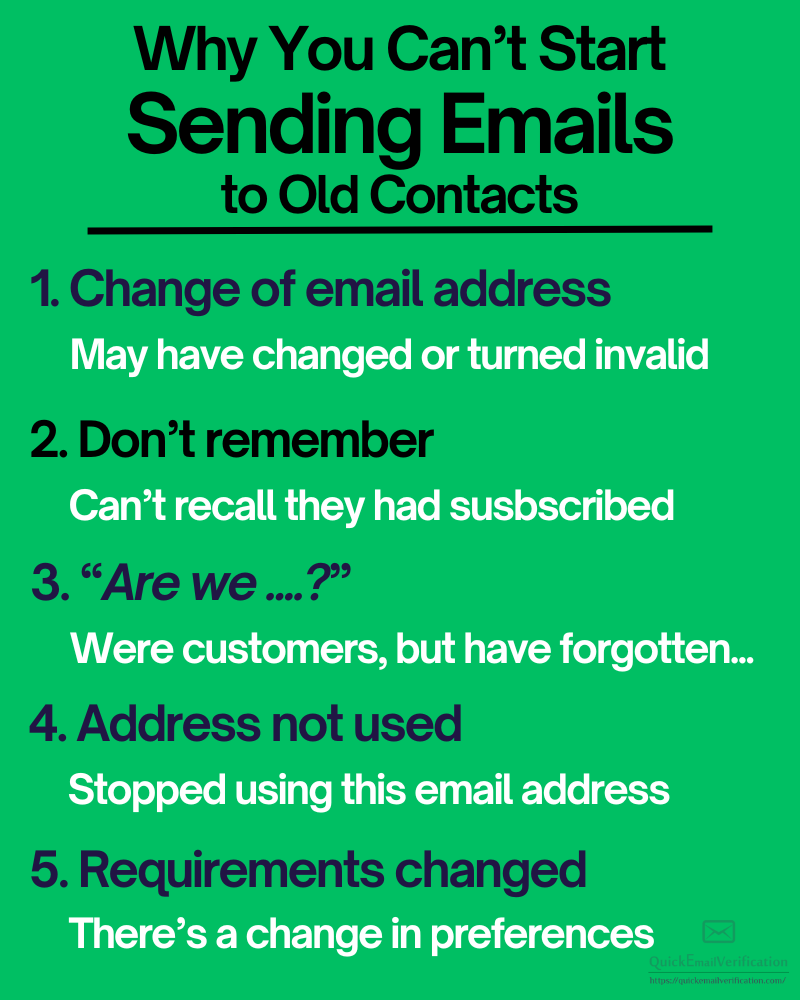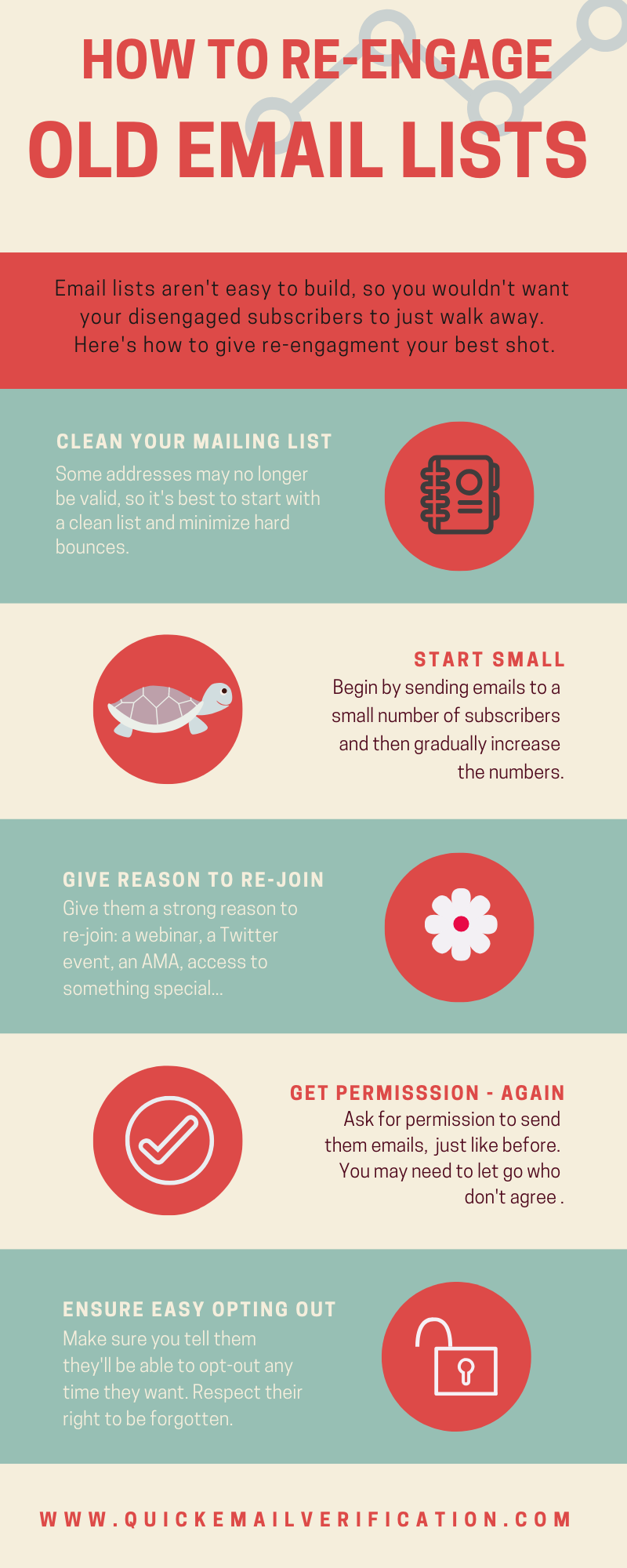Much of marketing today is in your email list. But growing your email list is not always easy, and purchased lists are always a big no-no. It takes time to grow your own email lists but it is worth it. There are many ways of growing mailing list effectively, if you have the right strategies in place.
Months later, when your list grows to a respectable size, you might want to begin sending out your first email.
But wait.
If the list is more than 5 or 6 months old, and you haven’t sent a single email in that duration, you’ve virtually lost their permission to send them emails. That’s because it’s an old email list.
What is an old email list
A list with email addresses that you haven’t sent emails to in the past 5 to 6 months is an old email list. An old email list is also known as a stale list.
Old email lists are not uncommon in the marketing world. You might be a giant corporate or a small business owner – you might have collected email addresses in the hope of carrying out email marketing or sending out newsletters one day. But when you’ve not been in touch with your subscribers for months, you need to be a little cautious.
Why you should re-engage old email list
Of course the answer is obvious: You already have an email list of subscribers who, at some point of time, agreed to receive email communication from you, so why not use that?

However, here’s a brief set of reasons why you re-engage an old email list:
- Sunk cost: You already had invested your resources and energy in building the list. You might as well use it.
- New business: Chances are some those disengaged subscribers may still choose to buy from you, if you reach out the right way.
- Time saved: If you were to begin building a fresh list from scratch, it’s going to take time.
- Familiar audience: Many, if not all, subscribers on your list may still be familiar with your brand even though it’s been some time since they signed up. Conversion is easier with such groups.
- Lower costs: A major part of expense has already been made in building the list. Now the costs involve cleaning the email list and sending the emails, which aren’t as big as that building the list.
- Better ROI: Don’t forget email marketing gets you an awesome ROI and can beat a number of alternative marketing channels.
- Automation: With a huge number of automation software, you can set a lot of your future campaigns on the auto mode.
- Mobility: A whopping 66% of emails are read on hand-held devices, which means subscribers will carry your emails everywhere. What more can you ask for?
- Analytics: Open rates, click-through rates and engagement rates provide you data-backed insights for smarter decisions.
Can I simply start sending emails to everyone on my old email list
No.
Here’s why you shouldn’t simply start sending email to everyone on your old email list:
1. Addresses may have changed and may no longer be valid.
Your subscribers may have moved. They might have changed jobs or even moved to some other international location (so johndoe@somecompany(dot)us is now on johndoe@somecompany(dot)fr). Alternatively, they might have changed their mailbox service provider.
In all these cases, any email you send out will bounce.
2. They have forgotten they subscribed
This should not be surprising, considering that many of them signed up as much as 6 months back and you have never written to them since. Naturally, they have forgotten they signed up with you.
That means if you email them abruptly, they are likely to not recall you and probably mark you as spam. Result? Email deliverability issues in future.
3. They have forgotten they are your customers
It’s not just subscribers who forget they signed up; even your customers occasionally forget!
If someone bought sunglasses from your shop or used your house cleaning services 4 months back, it’s possible they have forgotten you.
4. Some addresses are no longer used
The email address isn’t closed but it’s no longer used. This can often happen with subscribers who are trying to deal with spam and have moved from one email service provider to another.
In this case, the email you send won’t bounce, but it will never be opened or read either.
5. Subscriber requirements have changed
Owing to factors like changes in job profiles or personal preferences, some of your subscribers may no longer be interested in the kind of information you share.
Since you haven’t been in touch with them over the past few months, you have no idea that they are no longer your target group.
The below image summarises why you can’t begin sending emails to old email lists just like that.

Risks of sending emails to old lists
As you just read, there are a number of risks associated with abruptly sending emails to old lists.
Following are the three main risks of sending emails to old lists without taking the right precaution:
- If the addresses are invalid, your emails will bounce. A higher email bounce rate can negatively impact your sender reputation. That means the deliverability of your future emails might drop.
- Subscribers who don’t recall signing up are likely to mark your email as spam. As these spam complaints build up, there is a risk Internet Service Providers (ISPs) might begin suspecting you are a spammer. That can, in the long run, make them deliver some of your emails to even your engaged subscribers in their spam folders – where they will never be read.
- If you’re using the services of an Email Service Provider (ESP), bounces and spam complaints make them suspect you’re a spammer. That’s also because their IP addresses can be under risk of being labelled spammer by ISPs. In extreme cases, ESPs may refuse carrying emails on your behalf.
How to send emails to old lists and re-engage
Here are the set of activities you’ll need to carry out to re-engage with your old subscriber list and win back their attention:
1. Clean the email list
It always begins by cleaning the email list. Even if all addresses on your list are opt-ins, it’s strongly recommended you verify entire email list. A leading provider of email verification service will validate every email address. After the verification process, you will get a a separate list of valid email addresses and invalid addresses.
Additionally, you will also get to know which of the email addresses are disposable, accept-all or role-based. This will help you come to better, informed decisions as to whom you’d like to begin engaging with.
2. Start sending to a small number of subscribers
You may send your first email after you’ve checked the features of a bulk email verifier and used it to clean your email list.
But don’t send all your emails in one shot. Marketing experts suggest you first begin by sending an email to a small percentage of your subscribers. See how they respond and engage. Once you get a foothold, you can increase the numbers gradually.
Apart from that, write your email copy carefully. Remember to re-introduce your company and remind them gently that they had signed up. It will help your subscriber establish the context, without which they will likely think you’re a spammer and hit the Spam button.
Another good thing would be to insert high-engagement campaigns between these ‘test-drive’ small volume campaigns you’re sending. That will maintain the reputation of the IP you’re using.
3. Give them reason to re-join
If they’ve moved out of your engagement zone, there must have been a reason.
To get them back into your list of engaged subscribers will likely need a reason too.
You can consider organizing a re-engagement event like AMA (Ask Me Anything), webinar, online class, Twitter event, a new e-book covering the learning of the past X months… there’s no shortage of events you think of.
A re-engagement event is important because it reminds your ‘dead’ subscribers what value you offer. It gently nudges them that they’ve been missing out something important. Additionally, an event will give you an opportunity to update subscribers with what’s been happening when they were away and also tell them if you’re launching a new product.
4. Confirm like double opt-in
You’re getting back in touch after 4 to 6 months or more, right? So even if they remember signing up and what amazing product you offer, their own preferences and requirements may have changed. May be some of your subscribers on the list no longer find whatever you sell interesting or relevant.
Therefore, just like you do with double opt-in emails, ask for their confirmation. Ask the subscriber to click on a link in your email only after which you will send them the next email. Naturally some of them won’t click and you’ve to let them go, but the ones that do click and express willingness to receive emails from you are the ones you’d want to engage with.
5. Make it clear they can opt out any time
Subscribers love, and have a right to, having control on what they receive. Respect their rights.
Explain how they are always free to opt out anytime they want – no questions asked. Tell them being on the mailing list is absolutely voluntary and that they can leave anytime they wish to.
However, be a smart marketer. While you explain they can control their subscriptions and can unsubscribe anytime they’d wish to, explain what all things they will miss. They will miss out all the great consumer stories, amazing case studies or industry insights you share.
Give your subscribers enough reason to stay back. Remember what John Hayes said, “Bait without hook is food.”
Email marketing offers great opportunities so we hope you’ll be able to make the most out of your old email lists.
Infographic on how re-engage old email lists
Here’s an infographic that summarizes the above material:
If you think we missed out something important, feel free to comment below!
Good luck and happy marketing!


